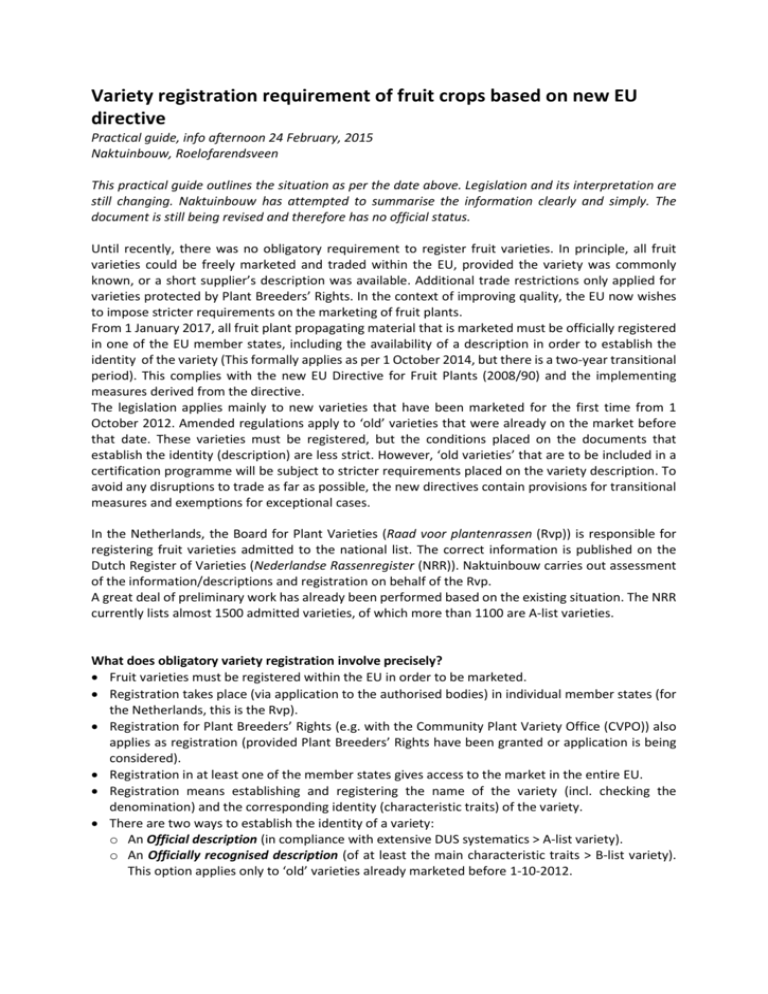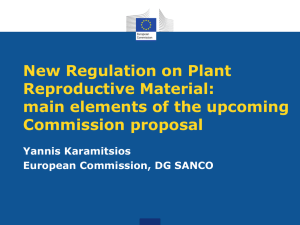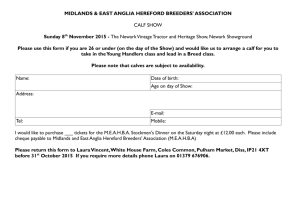document - Raad voor plantenrassen
advertisement

Variety registration requirement of fruit crops based on new EU directive Practical guide, info afternoon 24 February, 2015 Naktuinbouw, Roelofarendsveen This practical guide outlines the situation as per the date above. Legislation and its interpretation are still changing. Naktuinbouw has attempted to summarise the information clearly and simply. The document is still being revised and therefore has no official status. Until recently, there was no obligatory requirement to register fruit varieties. In principle, all fruit varieties could be freely marketed and traded within the EU, provided the variety was commonly known, or a short supplier’s description was available. Additional trade restrictions only applied for varieties protected by Plant Breeders’ Rights. In the context of improving quality, the EU now wishes to impose stricter requirements on the marketing of fruit plants. From 1 January 2017, all fruit plant propagating material that is marketed must be officially registered in one of the EU member states, including the availability of a description in order to establish the identity of the variety (This formally applies as per 1 October 2014, but there is a two-year transitional period). This complies with the new EU Directive for Fruit Plants (2008/90) and the implementing measures derived from the directive. The legislation applies mainly to new varieties that have been marketed for the first time from 1 October 2012. Amended regulations apply to ‘old’ varieties that were already on the market before that date. These varieties must be registered, but the conditions placed on the documents that establish the identity (description) are less strict. However, ‘old varieties’ that are to be included in a certification programme will be subject to stricter requirements placed on the variety description. To avoid any disruptions to trade as far as possible, the new directives contain provisions for transitional measures and exemptions for exceptional cases. In the Netherlands, the Board for Plant Varieties (Raad voor plantenrassen (Rvp)) is responsible for registering fruit varieties admitted to the national list. The correct information is published on the Dutch Register of Varieties (Nederlandse Rassenregister (NRR)). Naktuinbouw carries out assessment of the information/descriptions and registration on behalf of the Rvp. A great deal of preliminary work has already been performed based on the existing situation. The NRR currently lists almost 1500 admitted varieties, of which more than 1100 are A-list varieties. What does obligatory variety registration involve precisely? Fruit varieties must be registered within the EU in order to be marketed. Registration takes place (via application to the authorised bodies) in individual member states (for the Netherlands, this is the Rvp). Registration for Plant Breeders’ Rights (e.g. with the Community Plant Variety Office (CVPO)) also applies as registration (provided Plant Breeders’ Rights have been granted or application is being considered). Registration in at least one of the member states gives access to the market in the entire EU. Registration means establishing and registering the name of the variety (incl. checking the denomination) and the corresponding identity (characteristic traits) of the variety. There are two ways to establish the identity of a variety: o An Official description (in compliance with extensive DUS systematics > A-list variety). o An Officially recognised description (of at least the main characteristic traits > B-list variety). This option applies only to ‘old’ varieties already marketed before 1-10-2012. These descriptions must be drawn up or officially recognised by authorised bodies (in NL, the Rvp is responsible). Each member state is obliged to publish the registered varieties on a national list that is publicly accessible (in NL, this is the NRR). Registration is, in principle, valid for 30 years; renewal is possible if the variety is still being marketed (for another period of up to max. 30 years); renewal can be requested by the company or at the discretion of the authorities. Deleting a variety from a national list is possible (e.g. if conditions are no longer met, or if, at a later date, it appears that incorrect information was supplied when requesting admission) Which fruit plants fall under the obligatory variety registration requirement? All economically important fruit plants within the EU (see list below as stated in the directive). Plants not included in the directive do not have a registration requirement (e.g. kiwi, sea buckthorn, medlar and mulberry). Vines are covered by a separate directive (vines), with specific regulations (Directive 68/193/EC). Non-directive plants can be registered on a voluntary basis. List of genera and species covered by EU fruit plant directive 2008/90: Castanea sativa Mill. Citrus L. Corylus avellana L. Cydonia oblonga Mill. Ficus carica L. Fortunella Swingle Fragaria L. Juglans regia L. Malus Mill. Olea europaea L. Pistacia vera L. Poncirus Raf. Prunus amygdalus Batsch Prunus armeniaca L. Prunus avium (L.) L. Prunus cerasus L. Prunus domestica L. Prunus persica (L.) Batsch Prunus salicina Lindley Pyrus L. Ribes L. Rubus L. Vaccinium L. What is the difference between A and B list varieties (& relationship to certification)? A-list varieties have an official description (drawn up by and under the conditions of an authorised body within the guidelines of the directive) and material of the variety must be available. B-list varieties have an officially recognised description (for varieties pre-dating 1-10-2012). A- list varieties can be certified (provided they meet the conditions). A- list varieties for which the official description is still being applied for (via Plant Breeders’ Rights or registration) cannot certified yet; however plant material can already be propagated. B- list varieties cannot normally be certified. This can only be permitted by individual member states in exceptional circumstances (on request only, and the certifying body determines the conditions). In principle, official descriptions are available via the authorised bodies of the individual member states. Descriptions of varieties protected by Plant Breeders’ Rights are available from plant breeders’ rights agencies (e.g. CPVO). Officially recognised descriptions are held by the authorised bodies of the member states, but in practice they are not often published publicly (and are not asked for in the directive). The descriptions do often originate from a public source. Each member state must provide its official descriptions or officially recognised descriptions to other member states if so requested. When can I market propagating material of a variety? If a variety is registered on the NRR or in one of the EU-member states as an A or B list variety. If a variety has Plant Breeders’ Rights in one of the EU-member states or with the CPVO. If registration of Plant Breeders’ Rights is being applied for: o This should be stated on the label (‘proposed denomination’ and ‘application being considered’). o If registration or the application for Plant Breeders’ Rights is rejected, the application request for official registration also expires, and the material may no longer be marketed within the EU. If a variety has Plant Breeders’ Rights protection in the EU (CPVO or one of the member states), additional registration in one of the member states is unnecessary. If Plant Breeders’ Rights expire or are ended, permission to market and certification is no longer valid - this can be continued by registering in one of member states. This can be done on request of a company, or on the initiative of a registration authority. The variety description from the Plant Breeders’ Rights agency can be adopted as the official description. If a variety is protected by Plant Breeders’ Rights in a third country, it cannot automatically be marketed within the EU. In this case, an application for Plant Breeders’ Rights within Europe is necessary, or registration in one of the member states. The table below illustrates this clearly. Status Listing on NRR Market Certification possible Plant Breeders’ Rights NL yes yes yes Plant Breeders’ Rights EU or other member unnecessary yes yes Registration in NL as A-list variety yes yes yes Registration in other EU-member state as A- unnecessary yes yes Registration in NL as B-list variety yes yes no, unless Registration in other EU-member state as B- unnecessary yes no, unless state list variety list variety Plant Breeders’ Rights /registration yes yes no, unless Rights /registration unnecessary yes no, unless Plant Breeders’ Rights third country (UPOV- necessary (or in other no member)* member state) registration application application (NL) Plant Breeders’ application (EU or member state) (only after no, unless in EU) *) still being discussed in Brussels What if I produce a variety, or wish to market one, that is not registered yet? If a variety is not listed on the NRR or registered in one of the EU-member states, and does not hold Plant Breeders’ Rights , then it should be registered (for exceptions, see section detailing this later) Application A-list variety for NRR: Is exceptional in the fruit sector. Practically all new varieties apply for European Plant Breeders’ Rights and can therefore be considered as an A-list variety. However, if admission to the A-list is wanted without Plant Breeders’ Rights , the procedure is as follows: o Submit plant material & relevant forms/info (TQ, proposed denomination, info registration in other member states or third countries, etc.) to Naktuinbouw. o Application and testing fees must be paid (in accordance with DUS testing Plant Breeders’ Rights). o DUS testing is performed; official description is drawn up (2-6 years, depending on the plant). Application for B-list variety for NRR: o Only possible for ‘old’ varieties (already on the market before 1-10-2012). o Submit name & brief variety description to Naktuinbouw. o After recognition of name & description, the variety will be accepted for listing on the NRR. o In principle, application fees, testing fees and/or authorisation fees apply. These fees will be determined in NL before 1-1-2017. Table with (provisional) fees for fruit Possible action Fee Application Plant Breeders’ Rights and/or admission € 430 Additional application Plant Breeders’ Rights or admission € 55 Cost DUS testing (for Plant Breeders’ Rights or admission) Fee testing station Adopting report € 240 Registration & assessment B-list variety (from 2017; until then in € 255 consultation) What if I have plant material that used to be eligible for marketing and/or certification? In certain cases, propagating material used to be eligible for certification and marketing, but is no longer eligible under the new legislation. A transitional period (to avoid too many disruptions to trade) is in place for existing material (originating from existing mother plants of pre-basic, basic, certified and CAC material). Until 31-12-2022, this existing material may be marketed on the own territory of the member state. Which additional requirements/exceptions apply for rootstocks? The propagating material may also be a botanical species or hybrid species, and does not have to be an independent variety (only for CAC). If the rootstock is a variety not stated in the directive (e.g. Prunus spinosa), but the fruit variety grafted onto it is, an obligatory, official registration is still required for the rootstock variety. What are the other exceptions? Additional requirements for admission apply for genetically modified plants (GMOs) (see Directive 2001/18/EC. If the material is used for breeding purposes and/or plays a role in preserving genetic diversity, exemption is possible (only on own territory). However, in combination with a suitable amount of propagating material. If the material is not used for the production of fruit destined for human consumption, but, e.g. for animal feed or derived foodstuffs, other directives may apply with corresponding (separate) conditions for variety registration. In the case of unforeseen circumstances (e.g. natural disasters), less stringent interpretation of the directive is possible (limited period) (via the Brussels procedure). What about mutants/clones of varieties? Mutants (also known as clones in practice) often occur of well-known and commonly cultivated fruit varieties. There are two possibilities: o The mutant/clone is so distinct from the mother variety that it is said to be a new variety. This new variety will be given its own variety denomination. o The mutant/clone is so indistinct from the mother variety that it cannot be formally recognised (based on DUS criteria) as a new variety. If a mutant/clone is recognised as a new variety, it will have the same status and systematics as every other variety. If a mutant/clone is not recognised as a new variety, in a formal sense the (propagation) material will belong to the mother variety (incl. any Plant Breeders’ Rights protection). Sometimes, in practical situations, these clones are important within the mother variety as they show slight abnormalities that it is desirable to keep distinct (e.g. slightly redder fruits, earlier ripening, etc.) Such mutants/clones that are used in practice should be included on national variety lists such as the NRR. Acceptance & (recognised) description by the national authority is required in this case. The NRR will do this by stating clone separately behind the name of the variety. In the event of certification, the name of the mutant/clone of the variety can also be stated on the tag. What about trade descriptions and brand names? Trade names and brands do not appear on the NRR as they provide no information/guarantee about the identity of the variety. Moreover, the status and use can change over time. Similar to in all other formal registers (UPOV, CPVO, other national variety lists) the variety name only (with any synonyms) is stated. This is sometimes complicated in practice (incl. inspections) as the trade description or brand name of certain varieties is better known than the actual variety name. For this reason, Naktuinbouw compiles and updates lists of these names internally (mainly for the purpose of adequate performance of supervision/inspections). This information is available internally via a trade list of fruit plants. Linking variety names to trade and brand names is only done for these internal purposes. Distinctions between trade descriptions and brand names (trademark protected) is not registered/checked by Naktuinbouw as this process involves too much work and evidence is often lacking. Trade descriptions and brand names listed on the internal trade list of fruit plants can, for the time being, also be stated on the tags, certificates and crate cards along with the variety name. Naktuinbouw does not state trademark symbols such as ® and ™, as they have no legal status in the Netherlands and it is impossible for Naktuinbouw to check the correctness and currentness of protection. Which information is/must be listed on the Dutch Register of Varieties? Denomination of the variety (variety identification) Any provisional variety identification. Plant name (genus and/or species; e.g. Prunus avium) Any synonyms used in NL. Any clonal identification within a variety. ‘Official description’ (A-list variety) or ‘Recognised description’ (B-list variety). Date of registration on the varieties register (=admission). Admission status: ‘admitted’ or ‘under consideration’. For registration of NL Plant Breeders’ Rights, some extra information may also appear: date of granting Plant Breeders’ Rights and status. End of validity of registration/ admission or any renewal of registration (max. 30 years each renewal). Where can I find relevant information? Board for Plant Varieties (Raad voor plantenrassen ) for general information, forms and procedures (www.raadvoorplantenrassen.nl) Dutch Register of Varieties (Nederlandse Rassenregister): www.raadvoorplantenrassen.nl/nl/rassenregister.nl Other National Registers in member states (under development) o The majority do not yet have variety registers for fruit o Federal Plant Variety Office (Bundessortenamt): www.bundessortenamt.de/internet30/index.php?id=8 o GEVES / NIAB / etc. Community Plant Variety Office: www.cpvo.europa.eu/main/nl/ UPOV/PLUTO: www.upov.int/pluto/en/ o For now, the most useful source of information with collected data from various member states and the CPVO. o Not up-to-date (member states submit information approx. 1 x per year). o Registration necessary (incl. user name and password). Registration is free. At some stage, the EU will create a common database of all the national variety lists (but probably not common European catalogues such as those for agricultural plant and vegetable species). For further information: Gerben Mellema (Inspections top fruit; g.mellema@naktuinbouw.nl; + 31 6-29550622) Frans Claassen (Inspections soft fruit; f.claassen@naktuinbouw.nl;+ 31 6-29550663) Marco Hoffman (Variety Registration; m.hoffman@naktuinbouw.nl; + 31 6-46841020)




